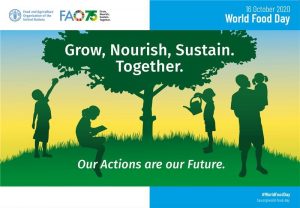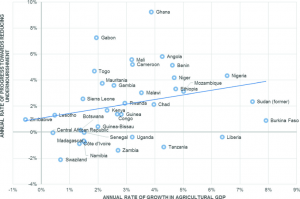A Reflection on World Food Day 2020: The Road Ahead for Smallholder Agriculture
- 02
- Nov

World Food Day 2020 with FAO
The Food and Agriculture Organisation (FAO) turned 75 on the 16th of October that coincides with the annual celebration of World Food Day. In spite of its senior age, FAO’s mission to end hunger and strengthen nutrition action remains all the more relevant today during the global health crisis caused by the Covid-19 virus. This year’s World Food Day’s theme ‘grow, nourish and sustain. Together’ called for urgent action through the cohesive collaboration of the public and private sector implying shared ownership, responsibility and interest towards achieving the common goal of building back food systems better. Covid-19 has exposed the fragilities of integrated food systems and demanded that regulatory frameworks should be revisited urgently. On an optimistic note, the recovery offers the unique opportunity to transform the foundations of global food systems making them sustainable and resilient to unexpected future shocks and to facilitate a shift in mindsets regarding the roles and responsibilities of public and private sector actors. Food systems are at the crossroads of human, economic and environmental health, therefore aligning all three under a common robust framework matter.
Honouring the Work of Food Heroes
This year’s World Food Day brought to the forefront an important cause to EuroAfri Link that is honouring the work and dedication of what FAO calls ‘food heroes’. This category comprises all workers behind supply chains in production, plantation, harvest and transportation. Where smallholder farming is the most prevalent form of agricultural production, making positive progress towards a sustainable supply chain management demands attention to economic resilience and the wellbeing of farmers first. Being the backbone of food security in developing countries, smallholders account for up to 70% of national food production and are responsible for over half of the food calories grown globally.

The Challenges of Mapping Small Farms
However, the lack of information about the location of small farms renders it difficult to pin down the numbers of farming households and amount of land, and therefore to implement effective agriculture development policies. It would be helpful to identify groups of producers with similar production strategies, resources and constraints for mapping purposes in order that the appropriate technologies can be planned for use.
Placing Smallholder Farms at the Centre of the Discussion
Economic literature has shown that intervention on smallholder agriculture by targeting the negative externalities on production and distribution can have strong impacts on poverty reduction, improved nutrition and meeting the social goal of minimising inequalities. Smallholder agriculture production is closely connected with food security in three ways. Firstly, it makes food available through production. Most of which is part of subsistence food production to ensure self-sufficiency. Secondly, smallholder production is comparatively cheaper to flow or mass production given that real costs of food are lower. Thirdly, it provides a source of income for farming households, enabling them to access nutritious foods. There is extensive evidence to confirm the relationship with on the one hand smallholder agriculture growth and on the other nutritional outcomes and food security. Where countries implemented pro-smallholder agriculture growth policies, the resultant greater affordability of food meant that states experienced lower incidences of child stunting and mortality compared to countries that did not.
Figure 1 shows the relationship between smallholder agriculture growth and hunger levels in Sub-Saharan African countries

Modernising Smallholder Agriculture
Given that the majority of agriculture production is carried out by scale-scale producers, policy interventions on smallholder farming is fundamental to achieving the 2030 Sustainable Development Goals where nine out of seventeen are directly linked to the sector. Small farms are diversified and the barriers faced in food production and distribution are affected by their geographical location and the stage of structural transformation. Countries that are committed to modernising their smallholder farming agriculture systems are working to implement Green Revolution technologies and are beginning to experience the benefits of higher productivity of staple foods, poverty reduction and cheaper food prices. FAO has learned in its 75 years that to build sustainable food systems, innovative technologies and aggregation models (such as cooperatives) are indispensable to rectify the scale disadvantages of smallholders for the road ahead, transforming low productivity agriculture systems.
References
Abraham, M. and Pingali, P. (2020). ‘Transforming Smallholder Agriculture to Achieve the SDGs’. The Role of Smallholder Farms in Food and Nutrition Security. 173-209.
Samberg, L., Gerber, J., Ramankutty, N., Herrero, M. and West, P. (2016). ‘Subnational distribution of average farm size and smallholder contributions to global food production’. Environmental Research Letters. 11(12).
Author: Claudia Zaccari, Project Officer at EuroAfri Link
